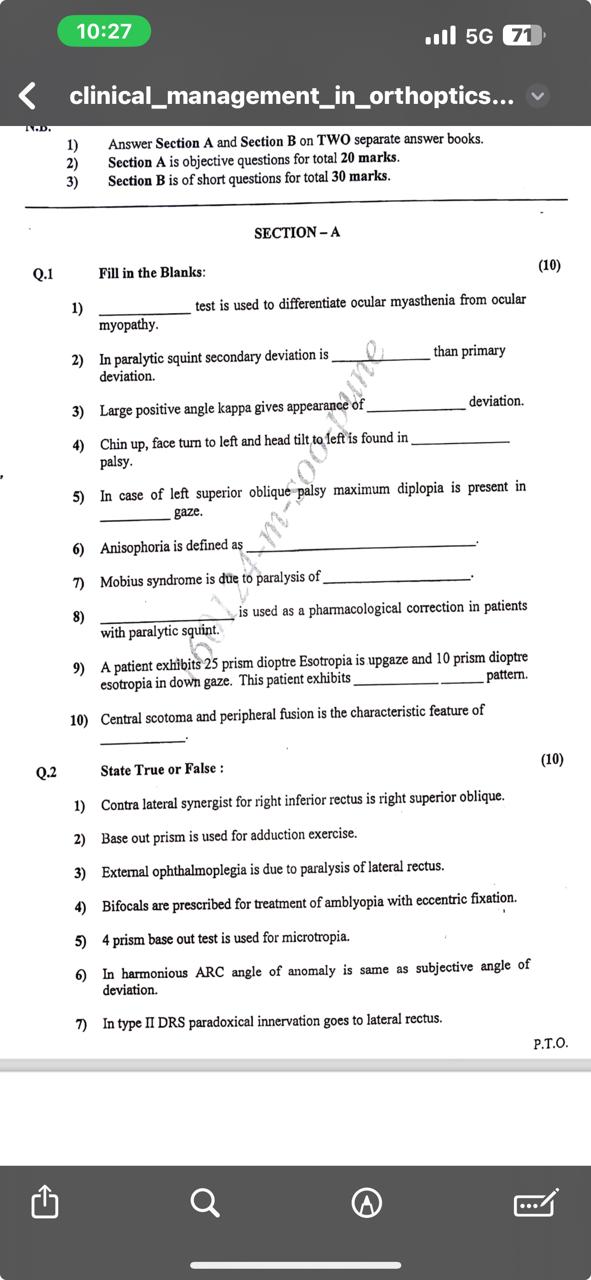Fill in the blanks: 1) ________ test is used to differentiate ocular myasthenia from ocular myopathy. 2) In paralytic squint secondary deviation is ________ than primary deviation.... Fill in the blanks: 1) ________ test is used to differentiate ocular myasthenia from ocular myopathy. 2) In paralytic squint secondary deviation is ________ than primary deviation. 3) Large positive angle kappa gives appearance of ________ deviation. 4) Chin up, face turn to left and head tilt to left is found in ________ palsy. 5) In case of left superior oblique palsy maximum diplopia is present in ________ gaze. 6) Anisophoria is defined as ______________________. 7) Mobius syndrome is due to paralysis of _____________________. 8) __________ is used as pharmacological correction in patients with paralytic squint. 9) A patient exhibits 25 prism diopter Esotropia is upgaze and 10 prism diopter esotropia in down gaze. This patient exhibits ________________ pattern. 10) Central scotoma and peripheral fusion is the characteristic feature of __________. State True or False: 1) Contra lateral synergist for right inferior rectus is right superior oblique. 2) Base out prism is used for adduction exercise. 3) External ophthalmoplegia is due to paralysis of lateral rectus. 4) Bifocals are prescribed for treatment of amblyopia with eccentric fixation. 5) 4 prism base out test is used for microtropia. 6) In harmonious ARC angle of anomaly is same as subjective angle of deviation. 7) In type II DRS paradoxical innervation goes to lateral rectus.

Understand the Problem
The question set consists of fill-in-the-blank and true/false statements related to clinical management in orthoptics. It tests knowledge on various ocular conditions, tests, and treatments.
Answer
1. Ice pack test, 2. More, 3. Exotropia, 4. Superior oblique, 5. Down, 6. Different refractive states, 7. VI and VII cranial nerves, 8. Botulinum toxin, 9. A-pattern, 10. Strabismic amblyopia
- Ice pack test. 2) More. 3) Exotropia. 4) Superior oblique. 5) Down. 6) Different refractive states in the two eyes. 7) VI and VII cranial nerves. 8) Botulinum toxin. 9) A-pattern. 10) Strabismic amblyopia.
Answer for screen readers
- Ice pack test. 2) More. 3) Exotropia. 4) Superior oblique. 5) Down. 6) Different refractive states in the two eyes. 7) VI and VII cranial nerves. 8) Botulinum toxin. 9) A-pattern. 10) Strabismic amblyopia.
More Information
Ocular myasthenia gravis (OMG) often requires specific tests like the ice pack test to differentiate from other myopathies. Understanding the difference between primary and secondary deviation, as well as recognizing patterns like A-pattern in esotropia, is crucial in ophthalmic diagnosis.
Tips
A common mistake is confusing primary deviation with secondary deviation in paralytic squint. Remember that secondary deviation is always greater than primary deviation in these cases.
Sources
- Case report: Importance of clinical tests in ocular myasthenia - PMC - ncbi.nlm.nih.gov
- Strabismus (Squint) | Ento Key - entokey.com
- pediatric strabismus surgery: Topics by Science.gov - science.gov